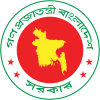Santahar City
This article has multiple issues. Please help improve it or discuss these issues on the talk page. (Learn how and when to remove these template messages)
|
Santahar
সান্তাহার | |
|---|---|
Santahar Junction Station Santahar Silo Lalmoni Express | |
| Nickname: Railway City | |
Location of Santahar in Rajshahi Division | |
| Coordinates: 24°48′26″N 88°59′10″E / 24.8071°N 88.9861°E | |
| Country | |
| Division | Rajshahi |
| District | Bogra |
| Population | 31,037 |
| Languages | |
| • Official | Bengali • English |
| Time zone | UTC+6 (BST) |
| Postal code | 5800-5899 |
Santahar (Bengali: সান্তাহার) is a municipality, and a town located in Bogura District, in Rajshahi Division, in Bangladesh. Santahar is mostly known for its agricultural activies and for being a transit hub. The town provides educational institutions, religious institutions, healthcare facilities, markets and shops, and other essential services for its citizens. Santahar has both urban and rural citizens. The landscape of Santahar includes rivers and agricultural fields that make up the town and its surroundings.
History
During the British colonial era, the British East India Company needed a stoppage at an intermediary point along their rail line from Kolkata to Siliguri. This prompted the reason for the creation of Santahar. Over time, Santahar evolved into a bustling transportation hub, facilitating the movement of goods and people, thus playing a pivotal role in its regional trade and logistics. Santahar had also become an active hub of agriculture at this point, particularity in rice cultivation.[1]
The town's strategic location facilitated the efficient movement of goods and personnel, thereby enhancing regional trade and connectivity. Over time, Santahar became integral to the economic and social fabric of northern Bangladesh, supporting agricultural activities and fostering local commerce.[2]
Under Pakistan's rule, Santahar was also settled by many Urdo speakers, also known as the Biharis. There were usual clashes between Bengali and Urdu speakers in the town and it is estimated 20,000 - 50,000 Biharis lived at Santahar at it's peak. Santahar had also witnessed the Santahar Massacre, which was massacre of non-Bengali speaking residents in the area, during Bangladesh's liberation war.[3][4]
Following Bangladesh's independence in 1971, Santahar continued to expand its railway infrastructure, adapting to technological advancements and evolving transportation needs. Today, the town remains an important junction on the Bangladesh Railway[5] network, contributing significantly to the country's transport sector and serving as a key link between major cities and regions, as well as a agricultural powerhouse.
Transportation
Road
The Dhaka-Santahar Highway provides a vital connection between Santahar and the capital city Dhaka, providing better access for trade and commerce.
The Bogra-Santahar road connects the town to Bogra, a regional power house, as well as other minor towns and cities.[6]
Railway
Many rail services in Bangladesh have a stoppage in Santahar, in its vital junction station. Being a vital connection for both freight and passenger rail services. Some passenger services may include: the Banglabandhu Express, Drujatan Express, and Lalmoni Express. The Mitali Express, which is a co-owned rail service between India Railways and Bangladesh Railway[7], also stops at Santahar, on its way to Siliguri from Dhaka.[8][9]
Public transport
Rickshaws are the main modes of transport within the city. Inter-city bus services also stop at Santahar.[10]
Demographics
Bengali is the main language for the people of the town. Many distinctive Bengali dialects and regional languages are also spoken, such as the North Central Dialect.[11]
Recent Events
- In 2021, Sheikh Hasina, inaugurated a brand new solar-powered silo in Santahar. The Silo has a capacity of 25,000 tons of food grains. This airconditioned and grand warehouse was constructed by the Department of Food, which costed 232 crore in taka and 27.4 million in U.S. dollars.[12]
See also
References
- ^ "Haunting images revisit the railways that united Bengal—until India's Partition divided it". History. 17 July 2024. Retrieved 17 July 2024.
- ^ "Ministry of Agriculture".
- ^ Kamrani, Farrukh (15 December 2017). "Fall of Dhaka: How Mukti Bahini 'cleansed' Santahar town of non-Bengalis". The Express Tribune. Retrieved 17 July 2024.
- ^ "Controversial book accuses Bengalis of 1971 war crimes". BBC News. 16 June 2011. Retrieved 17 July 2024.
- ^ "Santahar Railway Station Map/Atlas BR/Bangladesh Zone - Railway Enquiry". indiarailinfo.com. Retrieved 17 July 2024.
- ^ "Detailed Clear Large Road Map of Bangladesh - Ezilon Maps". www.ezilon.com. Retrieved 17 July 2024.
- ^ কন্ট্রিবিউটর (21 March 2022). "মিতালী এক্সপ্রেস ট্রেন - সময়সূচী, টিকেট ভাড়া ও প্রয়োজনীয় তথ্য". ভ্রমণ গাইড. Retrieved 17 July 2024.
- ^ "Bangladesh Railway E-ticketing Service". railapp.railway.gov.bd. Retrieved 17 July 2024.
- ^ "Santahar Station Train Schedule With Ticket Price 2023 | Updated". 1 May 2023. Retrieved 17 July 2024.
- ^ Shohoz.com. "Bus Tickets from Santahar to Dhaka|Buy Bus Tickets Online". Shohoz. Retrieved 17 July 2024.
- ^ Banerjee, Kelsey Ray (8 April 2023). "Exploring the Bengali Dialects: Beyond Diglossia". The Linguist Magazine. Retrieved 17 July 2024.
- ^ Bss, Unb (27 February 2017). "PM opens first solar-powered silo in Santahar". The Daily Star. Retrieved 17 July 2024.
- Pages using gadget WikiMiniAtlas
- Articles with short description
- Short description with empty Wikidata description
- Articles needing cleanup from July 2024
- All pages needing cleanup
- Cleanup tagged articles with a reason field from July 2024
- Wikipedia pages needing cleanup from July 2024
- Articles needing additional references from July 2024
- All articles needing additional references
- Articles with multiple maintenance issues
- Use Bangladeshi English from February 2023
- All Wikipedia articles written in Bangladeshi English
- EngvarB from July 2016
- Use dmy dates from July 2016
- Pages using multiple image with auto scaled images
- Coordinates on Wikidata
- Articles containing Bengali-language text
- Populated places in Rajshahi Division
- Cities in Bangladesh





